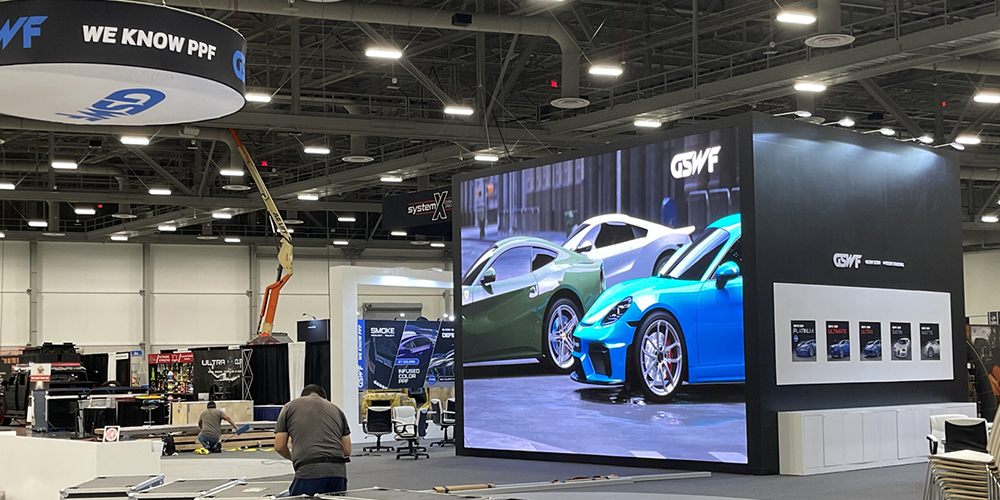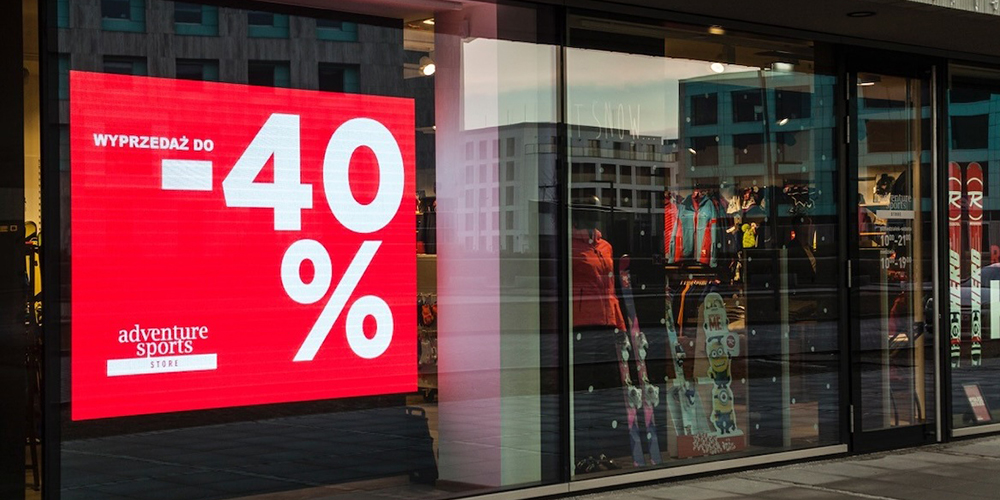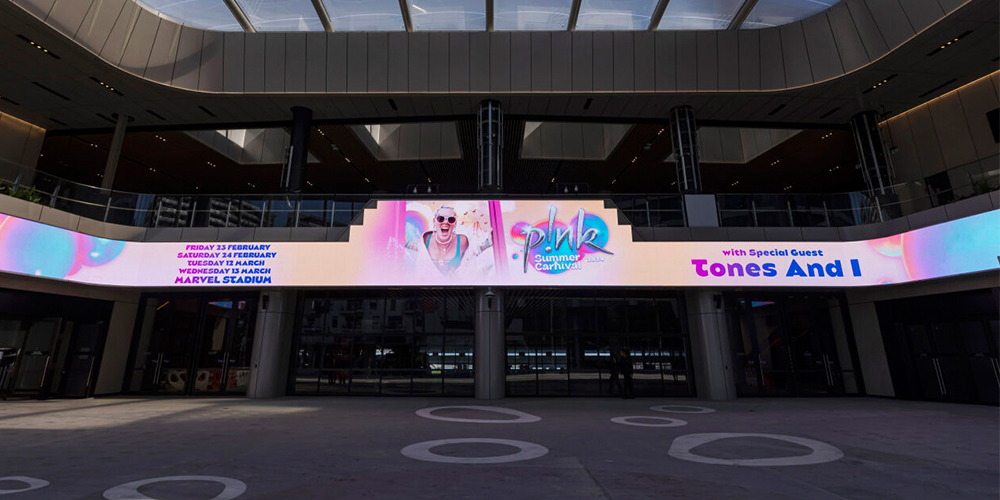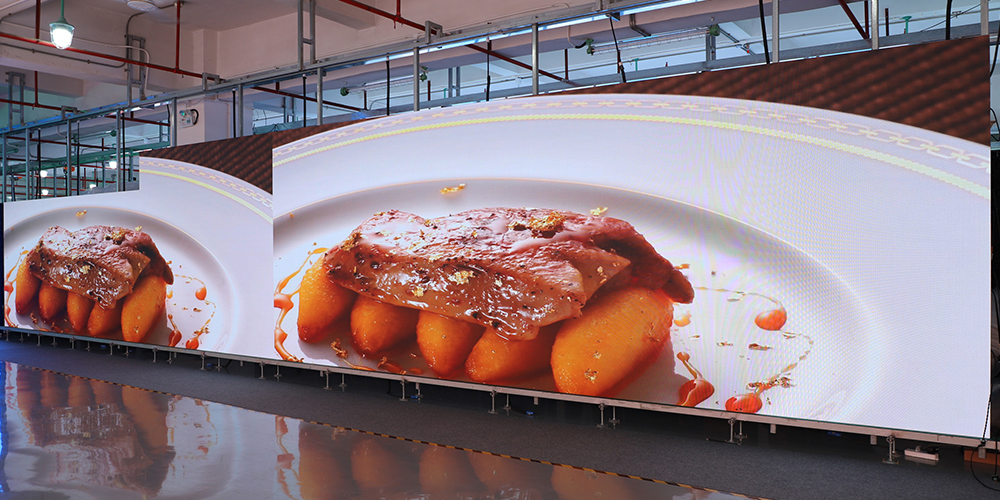These aren’t just oversized TVs slapped on a wall. LED screen panels are purpose-built, modular, and meant to scale. They’re turning bland facades into branded spectacles, and dark venues into immersive experiences. Whether you’re trying to sell a product, share data, or make a crowd feel something, LED display screen panels are how it’s done in 2025.
And yes, if you’re still thinking of projectors or clunky LCD walls… it’s time for an upgrade.
This guide walks you through everything that matters. What LED screen panels actually are, why they’re so dominant across industries, how to pick the right type for your setup, and what kind of ROI you can expect. We’ll even dig into rental vs. purchase decisions, smart features you didn’t know existed, and where the global market’s headed.
Let’s make sure your next display doesn’t just “work”, it wows.
1.What Exactly Is a LED Screen Panel Today?
Let’s keep it simple: LED screen panels are the modular units that make up today’s large-scale, high-impact displays.
Each panel is like a digital brick, engineered with LEDs, power units, and control cards, designed to snap together and form massive video walls, advertising displays, or dynamic stage backdrops. Put enough of them together? You get a seamless canvas that’s brighter, bolder, and way more flexible than any flat screen.
And they’re everywhere. From wraparound corner displays on buildings to pop-up stage setups at music festivals, screen LED panels are the tech behind the visuals that stop you in your tracks.
But here’s what really changed the game: modularity. You’re no longer locked into fixed sizes. Want to add more panels next month? Done. Need a curved edge or transparent section? Also doable. LED screen panels have become the toolkit of visual architects, not just another screen option.
Oh, and if you’ve heard terms like “LED display screen panel” or “modular LED wall”, same idea, different naming. The industry loves jargon, but it all comes back to these stackable units that power the world’s biggest and brightest displays.
2.Key Advantages of Modular LED Screen Panels
So, why are LED screen panels winning over projectors and video walls?
Because they just work, better, longer, and louder (visually speaking).
Let’s break it down:
- They’re pixel-accurate at any scale:Whether you’re stacking 4 or 400, each LED display screen panel maintains sharpness thanks to high-density RGB LEDs and tight pixel pitches (some under 1mm). Translation: crystal-clear content, even up close.
- Built for 24/7 reliability:These panels aren’t delicate. LED screen panels have their own power supply, ventilation, and control logic. Fire it up and it just goes, no warm-up, no stuttering.
- Perfect indoors, unstoppable outdoors:Indoors, you get fine detail and vibrant color. Outdoors? It’s all about brightness, up to 10,000 nits, with IP65 weather protection, anti-UV coatings, and rugged chassis. An outdoor LED panel can handle sun, rain, and even tropical humidity.
- They run cool and quiet:Newer screen LED panel designs dissipate heat efficiently and consume less power than projectors or LCD walls. That means less fan noise and longer lifespan, big win for event setups.
- No bezels. No breaks. Just screen:Unlike tiled TVs or LCDs, LED screen panels connect edge-to-edge with zero bezel interruptions. If your content needs to be smooth, fluid, and immersive? This is the format you want.
And here’s the kicker: you can start small. One wall today, three more next season. Modular LED screen panels are future-proof by design. They scale with your ambition, and your budget.
3.LED Panel Screen Application Scenarios
If you’re still thinking LED panels are only for Times Square or Super Bowl halftime shows, think again. These days, LED screen walls are showing up in the most unexpected, and effective, places.
Let’s talk real-world application.
3.1 Trade Shows & Exhibition Booths
Boring banners are out. Vibrant, modular LED screen panels are in. Exhibitors use them to show product demos, motion graphics, or even live-stream from another part of the venue. Because each LED display screen panel can be customized to the booth’s size and shape, brands get total creative freedom. Curved? Corner-mounted? No problem.

3.2 Retail Displays & Storefronts
You’ve seen them, bright, bezel-free screen LED panels stretching across glass windows or mounted above storefronts, rotating promotions, videos, and flash sales. Unlike printed signage, these displays actually react to the day’s foot traffic. Swap content by the hour. Drive conversions with motion and light.

3.3 Stage Backdrops & Live Entertainment
Concerts, festivals, product launches, anytime you need a stage to feel bigger than life, a seamless LED screen wall delivers. Set designers use different pixel pitches for crowd-facing visuals versus close-up indoor views. Best part? No projection distance needed. These displays go right up to the talent.
3.4 Mall & Airport Installations
When you’re trying to capture attention in busy spaces, static signs don’t cut it. A well-placed LED screen panel wall turns passive foot traffic into active viewers. Whether it’s a massive overhead banner or a vertical tower running real-time ads, these screens are built to hold attention, and convert it.
Bottom line? LED screen walls aren’t just about size. They’re about flexibility, presence, and keeping up with how people consume information today, visually, fast, and often on the move.

4.Indoor vs. Outdoor LED Screen Panels
4.1 Indoor LED Screen Panels
In indoor environments, think showrooms, convention halls, lobbies, you don’t need insane brightness, but you do need fine pixel pitch. That means more LEDs per panel, tighter spacing, and sharper resolution up close.
- Typical brightness: 800–1,200 nits
- Pixel pitch: 0.9mm to 2.5mm
- Ideal for: Close viewing distances, clean visuals, high-end interiors
4.2 Outdoor LED Panels
Outdoor LED panels are engineered to survive whatever the weather throws at them, sunlight, wind, rain, dust, even salt air if you’re by the coast.
- Brightness: 5,000 to 10,000+ nits
- IP rating: IP65 or higher
- Pixel pitch: 4mm and up for long-distance visibility
- Built-in UV protection, anti-rust coating, and higher contrast for sunlight legibility
They’re mounted on billboards, rooftops, trailers, building facades, anywhere you need maximum exposure. And with modular LED screen panels, you can easily go from a small roadside screen to a full building wrap.
Quick tip:
If you’re buying for an event that spans both indoor and outdoor zones? Consider hybrid-ready panels that can adjust brightness automatically or offer swap-out modules depending on environment.
5.When Should You Invest in Panels?
If you’re still debating whether to rent or go all in on your own LED screen panels, ask yourself this: how often do you need to capture attention? Because if it’s more than once or twice a year, you’re probably spending more by not owning.
Who’s buying?
- Event companiestired of rental markups
- Retail chainsrolling out unified branding across locations
- Real estate developersinstalling dynamic site signage
- Cities and venuesreplacing static billboards with programmable displays
Why not stick with projectors or LCDs?
- They don’t hold up in bright environments
- They lose clarity with size
- They’re harder to scale, harder to maintain, and frankly, outdated
With LED display screen panels, you’re buying flexibility. A single investment covers years of promotions, campaigns, activations, and content changes, all without paying for extra print or screen rentals every time.
The ROI story
- Boosted foot traffic
- Longer dwell time
- More impulse buys (in retail)
- Higher ad rates (in real estate and venues)
Smart brands aren’t just buying LED screen panels for looks, they’re buying to outperform. And it shows.
6.Choosing the Rental LED Screen Panel
When planning an event, concert, or brand launch, choosing the right rental LED screen panel is crucial. It not only affects the overall visual presentation but also determines the efficiency of installation and the quality of audience engagement. Below are the key factors to consider when selecting a rental LED display:
6.1 Identify the Application Scenario (Indoor vs. Outdoor)
- Indoor Use: Choose LED screen panelswith moderate brightness and a smaller pixel pitch for clearer detail and sharper images.
- Outdoor Use: Go for LED screen panelswith high brightness and a weatherproof rating (IP65 or higher) to ensure stable performance in direct sunlight and harsh conditions.
6.2 Pixel Pitch
Pixel pitch determines the image clarity. The closer your audience is to the screen, the smaller the pixel pitch should be.
Recommended guidelines:
P2.6–P3.9: Ideal for close-range indoor stages or exhibitions
P4.8–P5.9: Suitable for outdoor setups with medium to long viewing distances
6.3 Cabinet Design and Installation Efficiency
High-quality LED screen panels for rental typically feature:
-
Lightweight aluminum cabinets for easy handling and stacking
-
Dual quick-lock systems for fast installation and teardown
-
Curved splicing compatibility for creative and flexible stage designs
6.4 Brightness and Refresh Rate
-
Brightness: For outdoor use, choose LED screen panels with at least 4000 nits; for indoor use, 1000–1500 nits is generally sufficient.
-
Refresh Rate: Opt for 1920Hz or higher to avoid flickering during live recordings or photography.
6.5 Brand Reliability and After-Sales Support
Work with experienced LED screen panel manufacturers and service providers that offer:
-
Stable and durable display performance
-
Technical support and spare parts availability
-
Custom solutions tailored to your event needs
7.Smart Features Now Built Into LED Screen Tech
Today’s screen LED panels aren’t just plug-and-play rectangles, they’re getting smarter, and fast.
If you’re investing in digital signage in 2025, you’re not just buying brightness and pixel density. You’re buying automation, remote access, and real-time intelligence that takes your content from static to strategic.
Here’s what’s new and genuinely impressive:
- Auto-brightness adjustment:Built-in light sensors detect ambient light and adjust output for optimal visibility. Whether it’s a cloudy morning or midday glare, your content looks consistent and sharp.
- Remote diagnostics:You no longer need a tech team on-site. With cloud-based tools, you can monitor panel temperature, power draw, playback status, and even detect dead pixels from anywhere. Downtime? Avoided.
- Sensor triggers and AI integration:Some LED screen panels are now equipped with motion sensors, temperature trackers, or traffic counters. This allows content to adapt, like switching to weather alerts, countdowns, or product ads based on audience flow or time of day.
- Dynamic content rotation:With built-in scheduling systems, you can queue multiple promotions, sync across multiple displays, and update content remotely with a few clicks. It’s campaign automation for the real world.
And it’s not just big corporations taking advantage. Small businesses, municipalities, and entertainment groups are tapping into these features to get more value from every pixel.
Because when your screen works smarter, your message hits harder, and your team works less to make it happen.
8.Global Trends Shaping LED Screen Panels Adoption in 2025
If 2024 was the year LED tech matured, then 2025 is the year it explodes. Global demand for LED screen panels is accelerating, not just in high-profile ad campaigns, but in architecture, civic design, sports, and even education.
8.1 Worldwide momentum:
- Asia-Pacificis leading the charge, especially in China, South Korea, and Singapore. From interactive transit stations to entire skyscrapers wrapped in curved LED screen walls, smart cities are going all-in on modular display infrastructure.
- North Americais laser-focused on event-driven adoption, concerts, stadiums, political rallies, and retail launches. Brands are using mobile outdoor LED panels and high-refresh-rate video walls to make their messages unforgettable.
- Europe, meanwhile, is all about eco-forward design. Expect to see ultra-light panel frames, solar-powered operation, and recyclable components become part of the standard build, especially in cities with green advertising regulations.
8.2 Tech shifts to watch:
- Foldable panelsthat collapse down for easy transport and quick pop-up setups at events
- Transparent LED displayslayered on glass, giving storefronts both aesthetics and function
- Solar charging systemsthat reduce operating cost and carbon impact
- AI-driven content managersthat rotate visuals based on audience density, time of day, or even local weather data
This is where LED screen panels go from just “tech” to urban infrastructure, creative canvas, and business tool, all rolled into one.
Looking ahead to 2027 and beyond, owning an LED screen won’t be about standing out, it’ll be about keeping up.
9.Conclusion
Let’s face it, visibility isn’t optional anymore. It’s the currency of attention. And in a world full of distractions, the right display isn’t a luxury, it’s your loudest, sharpest advantage.
LED screen panels offer that edge. They’re not static billboards or passive monitors. They’re programmable canvases. Whether you’re trying to convert window shoppers, boost sponsor visibility, or launch a show that lives on in social media clips, LED display screen panels make it happen.
They scale with your vision, work across weather and venues, and, when done right, pay for themselves in results, not just impressions.
And with the right supplier like MuenLED, you don’t just buy equipment, you gain a partner who understands performance, precision, and what it takes to keep your display running (and converting) long after the launch.

